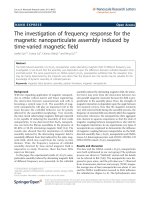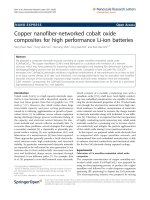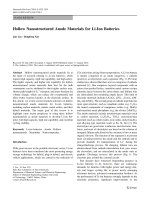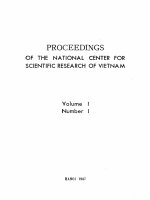Investigation of si anode for LI ion batteries
Bạn đang xem bản rút gọn của tài liệu. Xem và tải ngay bản đầy đủ của tài liệu tại đây (4.95 MB, 165 trang )
INVESTIGATION OF SILICON ANODE FOR
LITHIUM ION BATTERIES
OMAMPULIYUR SWAMINATHAN RAJAMOULY
(M. Eng., MIT; B. Eng. (Hons.), NUS)
A THESIS SUBMITTED
FOR THE DEGREE OF DOCTOR OF PHILIOSOPHY
IN ADVANCED MATERIALS FOR MICRO‐ AND
NANO- SYSTEMS (AMM&NS)
SINGAPORE‐MIT ALLIANCE
NATIONAL UNIVERSITY OF SINGAPORE
2013
i
Declaration
I hereby declare that this thesis is my original work and it has been
written by me in its entirety. I have duly acknowledged all the sources of
information which have been used in the thesis.
This thesis has also not been submitted for any degree in any university
previously.
Omampuliyur Swaminathan Rajamouly
17 January 2013
ii
Acknowledgements
This project would not have been feasible without the guidance,
support and encouragement of many people. I express my heartfelt gratitude to
Prof. Choi (SMA, NUS) for his invaluable guidance, unflinching
encouragement and constant belief in me. The weekly meetings with Prof.
Choi were crucial for me to be constantly cognizant of the project objectives
and it helped me through many a lean patch. Prof. Fitzgerald (SMA, MIT) has
been a great inspirational figure and was the main reason for me to embark
upon the anode investigation project, for which I thank him earnestly. Prof.
Thompson (SMA, MIT) has helped me greatly by guiding me through several
critical twists and turns of the project and I thank him sincerely. Prof. Lu
(NUS) allowed me to use his laboratory facilities for half-cell assembly and I
am greatly indebted to him. Prof. Thong’s (NUS) lab was of indispensable
value for my SEM and EDX analyses and I am very thankful to him. Prof.
Shao-Horn (MIT) helped me gain important electrochemical insights with
respect to the project and I genuinely thank her.
I would like to thank Koo Chee Keong for his help with numerous
SEM and EDX analyses. This project wouldn’t have become a reality without
the help of Xia Hui and Zhu Jing in assembling several half-cells, almost
every week. Maruf has been of great help in this project and aided me with
many an explorative discussion, and I am immensely thankful to him. I am
very much indebted to Mohammed Khalid and Zheng Han for all their help in
the Glancing Angle Deposition of gold. I am sincerely thankful to Zheng Fei,
iii
Tze Haw and Yun Jia; my senior laboratory mates for bringing me up to speed
with respect to all the operating procedures of laboratory equipment. I am also
very thankful to Lim Walter (lab officer), Hong Yanling (SMA) and Juliana
(SMA) for all the help during this project. Over the course of this project my
laboratory mates: Yudi, Ria, Zongbin, Cheng He, Changquan, Bihan, Zhu
Mei, Thi and Jia Xin have helped one way or the other and I thank them all. I
would also like to thank Lin Thu and Wang Kai for all their help and wish
them the very best in their projects.
I am greatly indebted to all my friends for their support and
encouragement over the course of this project. I thank my friend Krishandan
for helping me with the thankless and frustrating task of proof-reading my
thesis.
The ever growing fountain of scientific knowledge has only been made
possible by the ardent works of earlier intellectual stalwarts and was
succinctly expressed by Isaac Newton in : “If I have seen further, it is by
standing on the shoulders of giants”. I would like to take this opportunity to
express my boundless gratitude to all the researchers whose works have been
the basis and inspiration for my work.
“Parents, Teachers and only then god” has been a timeless Indian
adage, which underscores the importance of parents in our lives. I owe my
existence and all my opportunities to my kind and loving parents. My parents
have given me infinite support and immense encouragement over the course of
iv
my life and this research project. Though words cannot express the gratitude I
feel for them, I try and sincerely thank them for all the help, support and love.
v
Table of Contents
Acknowledgements ii
Summary x
List of Tables xii
List of Figures xiii
List of Acronyms xx
Chapter 1 Introduction 1
1.1 Background 1
1.2 Motivation 2
1.3 Organization of Thesis 3
Chapter 2 Literature Review 5
2.1 Introduction 5
2.2 Battery 5
2.2.1 Primary Batteries 8
2.2.2 Secondary Batteries 9
2.2.3 Lithium-ion Battery 10
2.3 Electrolytes for LIB 15
2.4 Cathodes for LIB 17
2.5 Anodes for LIB 18
2.5.1 Intercalation and de-intercalation 19
vi
2.5.2 Conversion Reaction 20
2.5.3 Alloying and de-alloying 20
2.6 Silicon Anode 25
2.6.1 Si powder anodes 27
2.6.2 Si dispersed in inactive or active matrix 28
2.6.3 Si thin films 30
2.6.4 Si nanostructures 33
2.7 Solid Electrolyte Interface (SEI) layer 38
2.8 Nanofabrication 40
2.8.1 Metal Assisted Chemical Etching 41
2.8.2 Glancing Angle Deposition 43
2.8.3 Laser Interference Lithography 44
2.9 Summary 47
Chapter 3 Experimental Details 49
3.1 Introduction 49
3.2 Nanoporous and nanopillar Si 49
3.3 Stainless Steel substrate preparation 52
3.4 Silicon Sputtering 55
3.5 BHF Cleaning 59
3.6 Glancing Angle Deposition of Gold 60
vii
3.7 MACE for nanoporous Si 62
3.8 Laser Interference Lithography for Nanopillars 64
3.8.1 Photo Resist Coating 64
3.8.2 Llyod’s mirror setup, exposure and development 65
3.8.3 O
2
Plasma 68
3.9 Thermal Deposition of Gold 69
3.10 MACE for nanopillar Si 70
3.11 Thin-film thickness measurement 71
3.12 Weight measurement 72
3.13 Scanning Electron Microscopy 73
3.14 Energy Dispersive X-ray Spectroscopy 75
3.15 Half-cell assembly and testing 75
Chapter 4 Silicon - Thin film 81
4.1 Introduction 81
4.2 Effect of Si thin film thickness 81
4.3 Effect of RF sputtering power 84
4.3.1 EDX analysis 86
4.3.2 Voltage profile and differential capacity 87
4.3.3 Thermodynamic calculations 90
4.4 Effect of oxygen incorporation on cycling performance 92
viii
4.5 Summary 94
Chapter 5 Nanoporous Si 96
5.1 Introduction 96
5.2 Residual film 96
5.3 Native Oxide Layer 99
5.4 Charging rate vs. capacity 102
5.5 Effect of nanoporous Si thickness 104
5.6 750 nm nanoporous Si – 50 cycles 110
5.7 Summary 111
Chapter 6 Nanopillar Si 113
6.1 Introduction 113
6.2 200 nm nanopillar Si 113
6.3 450 nm nanopillar Si 115
6.4 750 nm nanopillar Si 116
6.5 Charging rate vs. capacity 120
6.6 Areal specific capacity comparison 122
6.7 Summary 123
Chapter 7 Conclusions 124
7.1 Summary 124
7.2 Recommendations 127
ix
Bibliography 130
Appendix - List of Publications / Conferences 144
x
Summary
In this work, we investigate the performance of Silicon as rechargeable
Li-ion battery (LIB) anode. The objective of this study was to evaluate the
effect of sputtering parameters on the anode performance of Si thin film, and
to investigate nanostructuring via Metal Assisted Chemical Etching (MACE)
as a possible methodology to mitigate the debilitating problem of volume
expansion of Si on lithiation. Though Si has a much higher theoretical specific
capacity (4200mAhg
-1
) than commercially used carbon (370mAhg
-1
) based
anodes, Si undergoes large volume expansion (400%) which often leads to
pulverization and limits the use of Si as an anode material.
We have observed that Si thin film anode’s cycling performance
greatly depends on the thickness of the thin film, in that for thicknesses greater
than 200 nm the cycling performance is significantly degraded. Therefore, if
one wants to increase the areal capacity any further while maintaining good
cycling performance, nanostructuring is the direction to pursue. Also,
increasing the RF sputtering power during Si film deposition resulted in higher
gravimetric capacity and first cycle Coulombic Efficiency (CE), due to
decreased oxygen incorporation. Oxygen incorporation helped in enhancing
cycling performance with the tradeoff of reduced specific capacity.
Nanoporous Si were fabricated via Glancing Angle Deposition
(GLAD) of gold followed by Metal Assisted Catalytic Etching (MACE). We
have found that the residual layer thickness after MACE is critical in ensuring
good cycling performance, as removing it completely would mean peel off of
xi
the nanoporous layer from the substrate but too thick a residual film resulted
in degraded cycling performance. To ensure good cycling performance the
residual layer thickness should be limited to a maximum of 100 nm. Native
surface oxide played a role in controlling the CE of the anode during cycling
and it is paramount that any native surface oxide is removed before half-cell
assembly to ensure high CE. Nanoporous Si layer has one-dimensional
nanostructures and consequently had good rate performance. We also
observed that thinner nanoporous Si layer does not cycle as well as thicker
nanoporous Si layer as thinner nanoporous Si layer was not sufficiently
mechanically robust during cycling. Though 750 nm nanoporous Si was found
to cycle very well initially, their cycling performance eventually degraded due
to pulverization and peel off in certain areas of the substrate.
Ordered Si nanopillars were fabricated via Laser Interference
Lithography (LIL) and gold deposition followed by MACE. Good cycling
performance was observed for Si nanopillars of different heights: 200, 450 and
750 nm, due to their mechanical robustness over many cycles. This is
important as it ensures that to increase areal capacity further, higher
nanopillars can be used. Nanopillars being one-dimensional nanostructures
had good rate performance. Nanopillar Si performed significantly better with
respect to areal specific capacity compared to nanoporous and thin film Si.
Further increase in areal capacity by increasing the height of the nanopillars
could not be investigated in this work due to the slow deposition rates during
the initial thin film sputtering.
xii
List of Tables
Table 2.1: Primary Batteries [46] 9
Table 2.2: Secondary Batteries [46]. 10
Table 2.3: Li-Si system summary at 415
o
C [85], [86] 25
Table 3.1: Summary of sputtering power. 57
Table 4.1: Thin film deposition rate vs. RF power. 87
Table 7.1: Si anode summary. 126
Table 7.2: Nano-structured Si anode comparison. 127
xiii
List of Figures
Figure 2.1: Energy Storage Domains [43]. 6
Figure 2.2: Zn | Cu cell. 7
Figure 2.3: Portable Secondary Battery market [47], [48] 11
Figure 2.4: Total LIB market revenue and growth forecasts, 2006-2016 [48].
11
Figure 2.5: Comparison of the different battery technologies in terms of
volumetric and gravimetric energy density [3]. 12
Figure 2.6: First C/LiCoO
2
battery [1]. 14
Figure 2.7: Charge Discharge in 18650-cell [55]. 15
Figure 2.8: Electrolytes' Li Ionic conduction [1]. 17
Figure 2.9: Generic Voltage vs. Li Concentration for a single phase system
[78]. 22
Figure 2.10: Generic Voltage vs. Li Concentration for a two phase system
[79]. 22
Figure 2.11: Theoretical Capacity and Voltage vs. Li for alloying anodes. 24
Figure 2.12: Li-Si phase diagram [88] 26
Figure 2.13: Galvanostatic profile for micro-Si (10 um) anode (for different
cycle numbers) [5] 26
Figure 2.14: Cycling behavior of SiO
x
with different oxygen content and
particle [17]. 29
xiv
Figure 2.15: Cycling performance profiles of silicon film electrodes with
different thicknesses [24]. 32
Figure 2.16: Cycle life of 50nm a-Si thin film anode vs. designated charge
capacity [27] 33
Figure 2.17: Capacity vs. cycle number (a) for Si nanowires at C/20 [92], (b)
for Si nanowires at C/5 rate [30]. 35
Figure 2.18: Cycling of Si nanowires made by MACE [34]. 36
Figure 2.19: Nanosphere cycling [39]. 37
Figure 2.20: Si nano -pillar and -well cycling [40]. 38
Figure 2.21: GLAD deposited Si cycling [93]. 38
Figure 2.22: SEM image of (a) Si nanowires etched with Au catalyst and
H
2
O
2
/HF solution [114] (b) Si nanowires etched in an Ag(NO)
3
/HF solution
[120]. 42
Figure 2.23: Schematic diagram of GLAD without substrate rotation, (a)
Initial ad-atoms condensation and shadowing (b) Columnar film development
from ad-atom nuclei, and (c) directed growth towards the flux [124]. 44
Figure 2.24: GLAD nanostructures with constant α (a) no substrate rotation,
(b) substrate rotation by 180
o
, (c) slow rotation of substrate, and (d) faster rate
of rotation of substrate [124]. 44
Figure 2.25: Schematic diagram illustrating the formation of standing wave
from a two-beam-interference [127]. 45
Figure 2.26: Total dose distribution on PR due to the superposition of two
perpendicular exposures [129]. 46
Figure 2.27: SEM image of PR pattern with (a) 90
o
rotation in between
exposures and (b) 30
o
rotation in between exposures [130]. 46
xv
Figure 3.1: Schematic for fabrication of nanoporous Si. 50
Figure 3.2: Schematic for fabrication of nanopillar Si. 51
Figure 3.3: SS surface after polishing and acetone cleaning. 54
Figure 3.4: SS surface after polishing and HF cleaning. 54
Figure 3.5: Sputtering [134]. 56
Figure 3.6: SS Substrate held in position during sputtering with the help of
clean room tape. 59
Figure 3.7: Schematic diagram of the GLAD set up [137]. 61
Figure 3.8: Au clusters after GLAD [41]. 62
Figure 3.9: Nanoporous Si. 63
Figure 3.10: Lloyd’s Mirror Interference Lithography setup [139]. 65
Figure 3.11: Double exposure Interference Lithography [139]. 66
Figure 3.12: Tilt view of patterned PR. 67
Figure 3.13: Top view of patterned PR. 68
Figure 3.14: O
2
Plasma to remove residual PR 68
Figure 3.15: Schematic of a thermal evaporator [135]. 69
Figure 3.16: Ordered Si nanopillars. 71
Figure 3.17: Thickness measurement using step profiler. 72
xvi
Figure 3.18: Microbalance. 73
Figure 3.19: Schematic diagram of a SEM. 73
Figure 3.20: Schematic of half-cell assembly. 76
Figure 3.21: Discharge / Charge cycle of a Si anode with Li/Li
+
counter
electrode. 78
Figure 4.1: Cycling performance of n-Si thin films with different thickness
sputtered at 85W. 82
Figure 4.2: CE of Si thin films with different thickness. 83
Figure 4.3: Surface of (a) Si thin film before cycling, (b) 200 nm Si thin film
after 50 cycles, (c) 550 nm Si thin film after 50 cycles and (d) 1.1 um n-Si thin
film after 50 cycles 84
Figure 4.4: Discharge and Charge Capacity vs. cycle of 140 nm Si thin film
samples sputtered at 30W, 65W and 85W. 85
Figure 4.5: Coulombic efficiency vs. cycle of 140 nm Si thin film samples
sputtered at 30 W, 65 W and 85W. 85
Figure 4.6: EDX of Si sputtered at (a) 85 W, (b) 60 W, (c) 30 W and (d) 30 W
sputtered in O
2
86
Figure 4.7: Voltage profile for samples sputtered at (a) 30W, (b) 60W and (c)
85 W. 88
Figure 4.8: Differential capacity curves for samples sputtered at (a) 30W, (b)
60W and (c) 85 W. 88
Figure 4.9: Normalized cycling performance samples with different O
2
concentrations. 93
Figure 4.10: First Cycle CE for samples with different oxygen concentration.
94
xvii
Figure 5.1: Cycling performance of nanoporous Si with different residual film
thickness. 97
Figure 5.2: SEM image of nanoporous Si with ~ 100 nm residual film
thickness (a) before and (b) after cycling. 97
Figure 5.3: SEM image of nanoporous Si with ~ 300 nm residual film
thickness (a) before and (b) after cycling. 97
Figure 5.4: SEM image of nanoporous Si with ~ 500 nm residual film
thickness (a) before and (b) after cycling. 98
Figure 5.5: 450 nm nanoporous Si (a) with BHF dip and (b) without BHF dip.
100
Figure 5.6: Cycling Performance of samples with and without BHF dip. 100
Figure 5.7: Effect of BHF dip on CE. 101
Figure 5.8: Capacities of nanowire samples with different surface oxide
thickness [159]. 101
Figure 5.9: Nanoporous Si Capacity vs. Current density 103
Figure 5.10: Rate performance of VLS nanowires [86]. 104
Figure 5.11: Cycling of nanoporous Si with different thickness. 105
Figure 5.12: (a) Voltage Profile & (b) Differential Capacity of 450 nm
nanoporous Si; (c) Voltage Profile & (d) Differential Capacity of 750 nm
nanoporous Si 106
Figure 5.13: SEM images of 450 nm nanoporous Si (a) before cycling, (b)
after cycling acetone wash, and (c)&(d) after cycling DIW rinse at different
magnifications. 107
xviii
Figure 5.14: SEM images of 750 nm nanoporous Si (a) before cycling, (b) &
(c) after cycling and acetone wash at different magnifications, and (d) after
cycling DIW rinse. 107
Figure 5.15: Top view of 750 nm nanoporous Si after cycling and acetone
clean. 109
Figure 5.16: 750 nm nanoporous Si cycling performance – 50 cycles. 110
Figure 5.17: 750 nm nanoporous Si after cycling (a) Big islands, (b) Big and
small islands, and (c) complete peel off. 111
Figure 6.1: SEM image of 200 nm nanopillar Si (a) before cycling, (b) after
cycling & DIW rinse. 114
Figure 6.2: 200 nm nanopillar Si cycling 114
Figure 6.3: SEM image of 450 nm nanopillar Si (a) before cycling, (b) after
cycling & acetone rinse, and (c) after cycling & DIW rinse. 115
Figure 6.4: 450 nm nanopillar Si cycling 116
Figure 6.5: 750 nm nanopillar Si cycling 118
Figure 6.6: SEM image of 750 nm nanopillar Si (a) before cycling, (b) after
cycling & acetone rinse, (c) & (d) after cycling & DIW rinse at different
magnifications. 119
Figure 6.7: (a) Voltage Profile & (b) Differential Capacity of 750 nm
nanopillar Si. 119
Figure 6.8: Nanopillar Si: Capacity vs. Current density. 121
Figure 6.9: Rate performance of nanopillar array (SPA) [40]. 121
Figure 6.10: Areal specific capacity comparison. 122
xix
Figure 7.1: Total battery specific capacity as a function of anode specific
capacity (C
c
is the cathode specific capacity) [89]. 129
xx
List of Acronyms
BHF: Buffered Hydrogen Fluoride
CE: Coulombic Efficiency
CVD: Chemical Vapor Deposition
DIW: De-Ionized Water
EDX: Energy-dispersive X-ray
GLAD: Glancing Angle Deposition
LIB: Lithium-Ion Battery
LIL: Laser Interference Lithography
MACE: Metal Assisted Chemical Etching
PECVD: Plasma Enhanced Chemical Vapor Deposition
PR: Photo Resist
RF: Radio Frequency
RIE: Reactive-Ion Etching
SEI: Solid Electrolyte Interface
SEM: Scanning Electron Microscopy
SS: Stainless Steel
TEM: Transmission Electron Microscopy
VLS: Vapor-Liquid-Solid
XRD: X-Ray Diffraction
Chapter 1 Introduction 1
Chapter 1 Introduction
1.1 Background
The interest in battery technologies has sky rocketed since the
introduction of a plethora of handheld devices in the consumer market and
also due to the increased need for low emission vehicles. Batteries have come
a long way from the primitive galvanic cell with liquid electrolyte to the
commercially available solid-state electrolyte Li Ion batteries (LIBs) that are
commonly used in laptops, hand phones etc. LIBs are rechargeable batteries,
which make them environmentally friendly and satisfy the increasing energy
storage requirements of hand-held electronic devices. The anode of choice for
LIBs is carbon which was made commercially available in early 1990s [1].
The commonly used carbon based anodes will not be a suitable candidate for
rechargeable batteries in the future due to their low specific capacity
(372mAhg
-1
) [2], [3]. A lot of research has been devoted to silicon (Si) as a
possible LIB anode due to its very high theoretical specific capacity of 4200
mAhg
-1
[4]. Although Si has a very high specific capacity, a large increase in
volume (approximately 400% with the formation of Li
22
Si
5
alloy) during
lithiation prevents good cycling performance of Si anodes.
To mitigate the problem associated with volume expansion of the Si
anode on lithiation, many approaches have been researched such as: Si powder
anodes [5]-[8], Si dispersed in an inactive or active matrix [9]-[22], Si thin
films [23]-[27] and Si nanostructures [28]-[40].
Chapter 1 Introduction 2
In this work we investigated sputtered Si thin films and nanostructures
etched down from sputtered Si films as LIB anodes.
1.2 Motivation
Si nanostructures fabricated on metal current collectors without the aid
of any other composites or host/binder material will allow for maximum
capacity extraction from the Si anodes. Nanostructured anodes have the
following advantages:
1. High surface-area-to-volume ratio ensures that the strain
caused by volume expansion during lithiation can be
effectively handled.
2. The vacant space in between the nanostructures provides
enough room for the material to expand without pulverization.
3. Without any composites or binders, one-dimensional
nanostructures like nanowires or nanopillars are directly
connected to the current collector ensuring that each individual
nanostructure takes part in lithiation and delithiation. This
results in higher gravimetric capacity compared to anodes with
binders or composites.
4. Shorter Li diffusion lengths and increased surface area allow
for higher power density and results in good anode rate
performance.
Thin film anodes cannot cycle well if the thickness is above 200 nm
(as we will see in Sections 2.6.3 and 4.2) and to increase areal specific
Chapter 1 Introduction 3
capacity of Si anodes, nano-structuring is an effective direction. The need to
increase areal specific capacity and in view of the advantages enumerated
above, Si nanowires and nanopillars were investigated in this work. The
nanowires were fabricated via Glancing Angle Deposition (GLAD) of Au
followed by Metal Assisted Catalytic Etching (MACE) [41]. The nanopillars
were fabricated via Laser Interference Lithography (LIL) and Au deposition
followed by MACE [42].
Sputtered Si thin film formed the basis for our nanostructure
fabrication, and therefore we performed a thorough investigation of the effect
of sputtering parameters such as RF sputtering power and oxygen
incorporation on anode performance. Nanowire fabrication used in this work
was based on a lithography-free bottom-up technique, making it an easy and
relatively cheap technique. Nanowire fabrication used in this work is also
relatively cheap and easy, as the lithography technique is mask-less.
1.3 Organization of Thesis
This thesis is organized into seven chapters. Chapter 1 being the
introduction provides the background and motivation for this study along with
a brief outline of this thesis. Chapter 2 reviews the published works on various
topics that have been covered in this research work, along with some pertinent
fundamental theories. Given the scope and motivation of our research, works
done with respect to Si anodes will be carefully reviewed. Chapter 2 will end
with a review of the literature and the theory behind the nanofabrication
techniques used in this research work.
Chapter 1 Introduction 4
In Chapter 3, various experimental procedures employed in the
preparation, fabrication and electrochemical characterization of the various
samples prepared in this study will be explained.
In Chapter 4, the battery performance of Si thin film anodes will be
discussed. The effect of thickness and RF sputtering power on Si thin film
anode performance, along with the effect of oxygen incorporation in the thin
film on cycling performance will be presented.
In Chapter 5, the battery performance of nanoporous Si anodes will be
discussed. The effect of un-etched residual film, native surface oxide and
nanowire length on anode performance, along with the rate performance
nanowire anode will be presented.
In Chapter 6, the battery performance of ordered Si nanopillar anodes
will be discussed. Cycling performance of Si nanopillars of different heights
will be presented along with their rate performance. This chapter will conclude
with a discussion on areal specific capacity of all the anodes investigated and
rationale for the enhanced cycling performance of nanopillars.
The thesis will conclude with Chapter 7, which provides a summary of
the performance of all the different Si anodes. The last section of this chapter
will enumerate the scope for future research on nanostructured Si.









